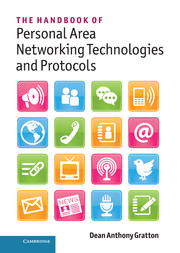Book contents
- Frontmatter
- Dedication
- Contents
- About the Author
- Making My Book Social
- Acknowledgements
- Before We Begin
- About This Book
- Part I What's In Your Area Network?
- 1 It's a Small Wireless World
- 2 What is a Personal Area Network?
- 3 Disruptive Topologies through Technology Convergence
- 4 Introducing the Lawnmower Man Effect
- Part II The Wireless Sensor Network
- Part III The Classic Personal Area Network
- Part IV Forthcoming Technologies and Conclusions
- Glossary
- References and Bibliography
- Index
- References
3 - Disruptive Topologies through Technology Convergence
from Part I - What's In Your Area Network?
Published online by Cambridge University Press: 05 September 2013
- Frontmatter
- Dedication
- Contents
- About the Author
- Making My Book Social
- Acknowledgements
- Before We Begin
- About This Book
- Part I What's In Your Area Network?
- 1 It's a Small Wireless World
- 2 What is a Personal Area Network?
- 3 Disruptive Topologies through Technology Convergence
- 4 Introducing the Lawnmower Man Effect
- Part II The Wireless Sensor Network
- Part III The Classic Personal Area Network
- Part IV Forthcoming Technologies and Conclusions
- Glossary
- References and Bibliography
- Index
- References
Summary
In Chapter 2, “What is a Personal Area Network?,” we started to reveal how, with the diversification of pervasive Wide Area Networking (WAN) communications, coupled with a breadth and diverse collection of wireless-enabled products with their associated applications, and with the consumer's ability to remain permanently connected to the one-network, a new generation of technologies and products has inadvertently spawned an era of disruptive topologies through technology convergence. In short, a plethora of connectivity opportunities have become openly available and widely encouraged – consumers have every reason and every opportunity to sustain that all-important IP-fix, irrespective of location. We discuss in Chapter 4, “Introducing the Lawnmower Man Effect,” how the Lawnmower Man Effect (LME) characterizes our ubiquitous ability to traverse digital systems across the globe, the one-network, as we illustrate in Figure 3.1.
There are several contributing factors which lead to consumers craving an IP-fix. One such obvious factor may simply be a trend to have immediate access to anything, anytime, anywhere. Another significant factor, which we discuss in Chapter 4, is social media. Social media platforms, such as Twitter, Facebook, Pinterest, LinkedIn, Foursquare, and so on, indirectly encourage consumers to maintain their online status and presence in the hope that they never miss a tweet or Facebook message from their virtual community, or perhaps to triumph through the adornment of a new badge awarded to them by Foursquare, as they oust their colleague to become Mayor of a popular business venue or restaurant.
- Type
- Chapter
- Information
- Publisher: Cambridge University PressPrint publication year: 2013

